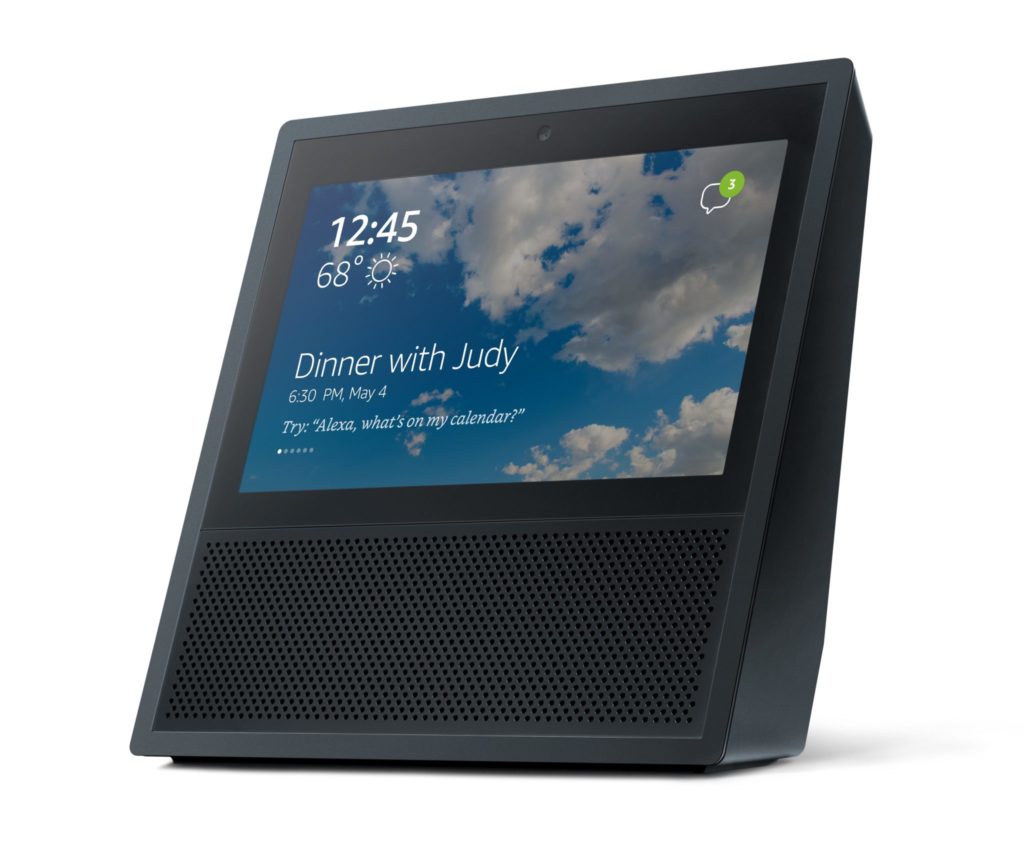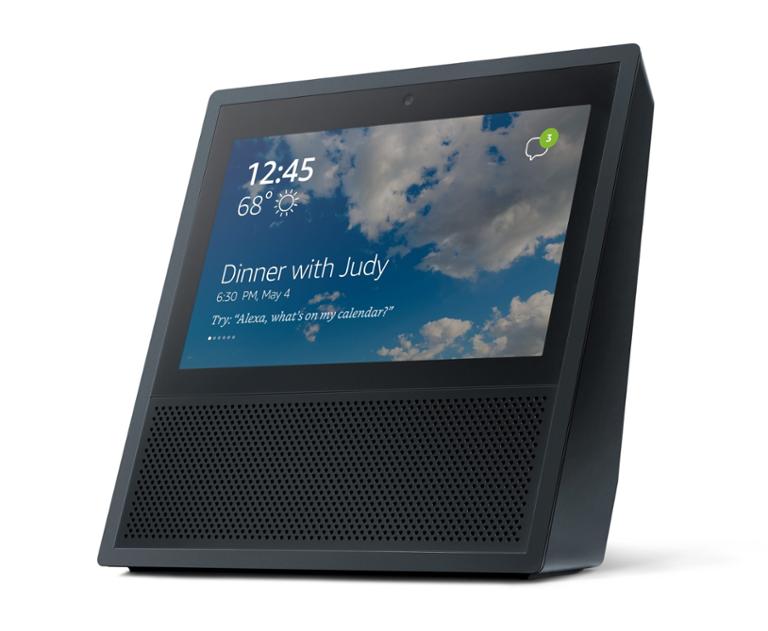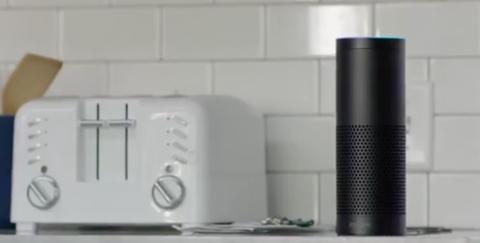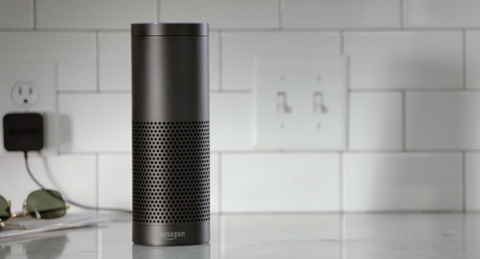 For months, rumors have percolated through the tech media that Amazon was working on a digital assistant with a screen. On May 9, that scuttlebutt came true when the e-commerce giant unveiled the Echo Show, a boxy device with a seven-inch screen. Amazon plans on shipping the Echo Show on June 28; it will cost $229.99. Features include video calling, a touch-screen, smart-home controls, and access to streaming-music services such as Spotify and Pandora. Previous iterations of the Amazon Echo lacked a screen; if you wanted to interface with Alexa, the cloud-based software that serves as the Echo’s “brain,” you needed to speak to it. That proved a useful method of interaction in certain circumstances: if you didn’t want to stand up and walk over to the device, for example, or couldn’t tap a button because your hands were full, the Echo could still answer your shouted queries. But the lack of a screen hobbled the Echo in other ways. It couldn’t display directions, or recipes, or movie times, or any of a thousand other types of information someone might need in the course of a given day. In that context, it seemed inevitable that a future iteration would feature a screen of some sort. Before Amazon rolled out the Echo Show, at least one rival criticized the lack of a display as a core failing. “The idea of not having a screen, I don’t think suits many situations,” Apple SVP Phil Schiller told NDTV. “I think voice assistants are incredibly powerful, their intelligence is going to grow, they’re gonna do more for us, but the role of the screen is gonna remain very important to all of this.” Despite those critiques about UX, Microsoft and Google both jumped aboard the screen-free digital-assistant bandwagon, announcing the Invoke and Google Home (respectively). Although Amazon controls 70 percent of the voice-enabled speaker market in the U.S., according to new data from eMarketer, Google has managed to seize 23.8 percent. The question now is whether these tech giants will add displays to their own products—and given the tit-for-tat nature of the consumer-tech industry, that seems likely. The prospect of digital assistants with screens begs another question: is this an ecosystem that will open up more to third-party developers? While the original Echo boasted a high number of third-party integrations (especially in terms of its connected-home functionality), a screen opens up opportunities for apps and games. (Amazon hasn't been forthcoming about its plans for Echo Show apps, although its developer site does offer a tutorial on building "skill cards" for Alexa.) While some developers and tech pros are doubtlessly salivating at the prospect of a whole new ecosystem—and millions of potential customers—digital assistants could prove a difficult medium for existing apps. For starters, these devices aren’t designed for sustained interaction; the user is meant to engage relatively briefly. That instantly precludes many categories of productive and “fun” apps. Second, the Echo Show lacks a physical keyboard, and despite the touch-screen, Amazon seems determined to retain voice as the primary means of interaction. That could likewise limit the functionality of any apps. It’s also questionable whether users will rely on digital assistants for apps when they already own a smartphone, tablet, laptop, and Internet-enabled television. Nonetheless, if these platforms are opened up, chances are good that at least some developers will find a way to build apps for them. At least for the moment, those "skill cards" seem the most likely route for putting visual content on the Echo Show.
For months, rumors have percolated through the tech media that Amazon was working on a digital assistant with a screen. On May 9, that scuttlebutt came true when the e-commerce giant unveiled the Echo Show, a boxy device with a seven-inch screen. Amazon plans on shipping the Echo Show on June 28; it will cost $229.99. Features include video calling, a touch-screen, smart-home controls, and access to streaming-music services such as Spotify and Pandora. Previous iterations of the Amazon Echo lacked a screen; if you wanted to interface with Alexa, the cloud-based software that serves as the Echo’s “brain,” you needed to speak to it. That proved a useful method of interaction in certain circumstances: if you didn’t want to stand up and walk over to the device, for example, or couldn’t tap a button because your hands were full, the Echo could still answer your shouted queries. But the lack of a screen hobbled the Echo in other ways. It couldn’t display directions, or recipes, or movie times, or any of a thousand other types of information someone might need in the course of a given day. In that context, it seemed inevitable that a future iteration would feature a screen of some sort. Before Amazon rolled out the Echo Show, at least one rival criticized the lack of a display as a core failing. “The idea of not having a screen, I don’t think suits many situations,” Apple SVP Phil Schiller told NDTV. “I think voice assistants are incredibly powerful, their intelligence is going to grow, they’re gonna do more for us, but the role of the screen is gonna remain very important to all of this.” Despite those critiques about UX, Microsoft and Google both jumped aboard the screen-free digital-assistant bandwagon, announcing the Invoke and Google Home (respectively). Although Amazon controls 70 percent of the voice-enabled speaker market in the U.S., according to new data from eMarketer, Google has managed to seize 23.8 percent. The question now is whether these tech giants will add displays to their own products—and given the tit-for-tat nature of the consumer-tech industry, that seems likely. The prospect of digital assistants with screens begs another question: is this an ecosystem that will open up more to third-party developers? While the original Echo boasted a high number of third-party integrations (especially in terms of its connected-home functionality), a screen opens up opportunities for apps and games. (Amazon hasn't been forthcoming about its plans for Echo Show apps, although its developer site does offer a tutorial on building "skill cards" for Alexa.) While some developers and tech pros are doubtlessly salivating at the prospect of a whole new ecosystem—and millions of potential customers—digital assistants could prove a difficult medium for existing apps. For starters, these devices aren’t designed for sustained interaction; the user is meant to engage relatively briefly. That instantly precludes many categories of productive and “fun” apps. Second, the Echo Show lacks a physical keyboard, and despite the touch-screen, Amazon seems determined to retain voice as the primary means of interaction. That could likewise limit the functionality of any apps. It’s also questionable whether users will rely on digital assistants for apps when they already own a smartphone, tablet, laptop, and Internet-enabled television. Nonetheless, if these platforms are opened up, chances are good that at least some developers will find a way to build apps for them. At least for the moment, those "skill cards" seem the most likely route for putting visual content on the Echo Show. Will Amazon Echo Show Allow Third-Party Apps?
 For months, rumors have percolated through the tech media that Amazon was working on a digital assistant with a screen. On May 9, that scuttlebutt came true when the e-commerce giant unveiled the Echo Show, a boxy device with a seven-inch screen. Amazon plans on shipping the Echo Show on June 28; it will cost $229.99. Features include video calling, a touch-screen, smart-home controls, and access to streaming-music services such as Spotify and Pandora. Previous iterations of the Amazon Echo lacked a screen; if you wanted to interface with Alexa, the cloud-based software that serves as the Echo’s “brain,” you needed to speak to it. That proved a useful method of interaction in certain circumstances: if you didn’t want to stand up and walk over to the device, for example, or couldn’t tap a button because your hands were full, the Echo could still answer your shouted queries. But the lack of a screen hobbled the Echo in other ways. It couldn’t display directions, or recipes, or movie times, or any of a thousand other types of information someone might need in the course of a given day. In that context, it seemed inevitable that a future iteration would feature a screen of some sort. Before Amazon rolled out the Echo Show, at least one rival criticized the lack of a display as a core failing. “The idea of not having a screen, I don’t think suits many situations,” Apple SVP Phil Schiller told NDTV. “I think voice assistants are incredibly powerful, their intelligence is going to grow, they’re gonna do more for us, but the role of the screen is gonna remain very important to all of this.” Despite those critiques about UX, Microsoft and Google both jumped aboard the screen-free digital-assistant bandwagon, announcing the Invoke and Google Home (respectively). Although Amazon controls 70 percent of the voice-enabled speaker market in the U.S., according to new data from eMarketer, Google has managed to seize 23.8 percent. The question now is whether these tech giants will add displays to their own products—and given the tit-for-tat nature of the consumer-tech industry, that seems likely. The prospect of digital assistants with screens begs another question: is this an ecosystem that will open up more to third-party developers? While the original Echo boasted a high number of third-party integrations (especially in terms of its connected-home functionality), a screen opens up opportunities for apps and games. (Amazon hasn't been forthcoming about its plans for Echo Show apps, although its developer site does offer a tutorial on building "skill cards" for Alexa.) While some developers and tech pros are doubtlessly salivating at the prospect of a whole new ecosystem—and millions of potential customers—digital assistants could prove a difficult medium for existing apps. For starters, these devices aren’t designed for sustained interaction; the user is meant to engage relatively briefly. That instantly precludes many categories of productive and “fun” apps. Second, the Echo Show lacks a physical keyboard, and despite the touch-screen, Amazon seems determined to retain voice as the primary means of interaction. That could likewise limit the functionality of any apps. It’s also questionable whether users will rely on digital assistants for apps when they already own a smartphone, tablet, laptop, and Internet-enabled television. Nonetheless, if these platforms are opened up, chances are good that at least some developers will find a way to build apps for them. At least for the moment, those "skill cards" seem the most likely route for putting visual content on the Echo Show.
For months, rumors have percolated through the tech media that Amazon was working on a digital assistant with a screen. On May 9, that scuttlebutt came true when the e-commerce giant unveiled the Echo Show, a boxy device with a seven-inch screen. Amazon plans on shipping the Echo Show on June 28; it will cost $229.99. Features include video calling, a touch-screen, smart-home controls, and access to streaming-music services such as Spotify and Pandora. Previous iterations of the Amazon Echo lacked a screen; if you wanted to interface with Alexa, the cloud-based software that serves as the Echo’s “brain,” you needed to speak to it. That proved a useful method of interaction in certain circumstances: if you didn’t want to stand up and walk over to the device, for example, or couldn’t tap a button because your hands were full, the Echo could still answer your shouted queries. But the lack of a screen hobbled the Echo in other ways. It couldn’t display directions, or recipes, or movie times, or any of a thousand other types of information someone might need in the course of a given day. In that context, it seemed inevitable that a future iteration would feature a screen of some sort. Before Amazon rolled out the Echo Show, at least one rival criticized the lack of a display as a core failing. “The idea of not having a screen, I don’t think suits many situations,” Apple SVP Phil Schiller told NDTV. “I think voice assistants are incredibly powerful, their intelligence is going to grow, they’re gonna do more for us, but the role of the screen is gonna remain very important to all of this.” Despite those critiques about UX, Microsoft and Google both jumped aboard the screen-free digital-assistant bandwagon, announcing the Invoke and Google Home (respectively). Although Amazon controls 70 percent of the voice-enabled speaker market in the U.S., according to new data from eMarketer, Google has managed to seize 23.8 percent. The question now is whether these tech giants will add displays to their own products—and given the tit-for-tat nature of the consumer-tech industry, that seems likely. The prospect of digital assistants with screens begs another question: is this an ecosystem that will open up more to third-party developers? While the original Echo boasted a high number of third-party integrations (especially in terms of its connected-home functionality), a screen opens up opportunities for apps and games. (Amazon hasn't been forthcoming about its plans for Echo Show apps, although its developer site does offer a tutorial on building "skill cards" for Alexa.) While some developers and tech pros are doubtlessly salivating at the prospect of a whole new ecosystem—and millions of potential customers—digital assistants could prove a difficult medium for existing apps. For starters, these devices aren’t designed for sustained interaction; the user is meant to engage relatively briefly. That instantly precludes many categories of productive and “fun” apps. Second, the Echo Show lacks a physical keyboard, and despite the touch-screen, Amazon seems determined to retain voice as the primary means of interaction. That could likewise limit the functionality of any apps. It’s also questionable whether users will rely on digital assistants for apps when they already own a smartphone, tablet, laptop, and Internet-enabled television. Nonetheless, if these platforms are opened up, chances are good that at least some developers will find a way to build apps for them. At least for the moment, those "skill cards" seem the most likely route for putting visual content on the Echo Show. 

